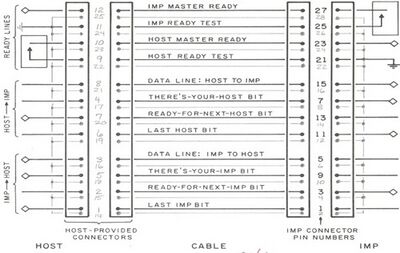Difference between revisions of "1822 interface"
m (+cat) |
(Explain 'ready/test' pairs now that we have the diagram; consistent tense) |
||
| (5 intermediate revisions by 2 users not shown) | |||
| Line 1: | Line 1: | ||
| − | + | [[Image:BBN-1822-IMP-host-interface.jpg|thumb|right|400px|IMP-host interface signals; note the relays on the two 'ready/test' pairs]] | |
| − | + | The '''1822 interface''' (named after the number of the [[Bolt, Beranek, and Newman|BBN]] report which specified it) was [[bit-serial]] data transfer interface used in [[data network]]ing. It was [[asynchronous]], with a handshake on every bit. | |
| − | + | It was originally specified for use in connecting a [[host]] to an [[Interface Message Processor|IMP]] on the [[ARPANET]], leading to the common naming of [[device controller]]s which produced an 1822 interface as [[IMP interface]]s; a number of different host 1822 interfaces were produced over the years. Somewhat later, the 1822 interface was adopted for the interface used to connect to the PRUs of the early [[Packet Radio Network]]; this was likely due in part because of the easy availability of a large range of host interfaces. | |
| − | + | At the very lowest layer, there were two different choices for the [[physical layer]]; 'Local Host' (LH), and 'Distant Host' (DH). (Technically, there was also a third, the 'Very Distant Host' (VDH), but it was an entirely different system from the other two; it was a [[synchronous serial line]] through a [[modem]], exactly the same as the system which the IMPs used to talk to each other, allowing a host to be many miles from the IMP it was attached to. It was not at all similar to the interface discussed here, so is not covered here.) | |
| − | + | The first two were operationally the same, and differ only in the lowest-level physical [[analog]] details: LH used [[single-ended signalling|single-sided]] [[transistor-transistor logic|TTL]] signals over [[twisted pair]]s, with a [[ground]] being the other [[conductor]] in the pair; DH used [[differential pair]]s, with ground isolation on the IMP end. | |
| − | + | The 1822 interface also included two pairs of 'ready/test' lines (one pair from the IMP, and one from the Host); one conductor of each pair was connected to the other via a [[relay]] at the responsible machine's end when that machine wanted to signal that it was ready. (One of the pair was usually connected to ground at the source; the other line could then be tested to see is it too was at ground.) | |
| − | + | There was no fixed [[word]] length, the IMP was prepared to talk to machines with different word lengths. | |
| − | |||
| − | |||
| − | |||
| − | |||
| − | |||
| − | |||
| − | |||
==See also== | ==See also== | ||
| Line 24: | Line 17: | ||
* BBN Report #1822, [http://www.bitsavers.org/pdf/bbn/imp/BBN1822_Jan1976.pdf Specification for the Interconnection of a Host and an IMP] - The 1976 revision of this key document | * BBN Report #1822, [http://www.bitsavers.org/pdf/bbn/imp/BBN1822_Jan1976.pdf Specification for the Interconnection of a Host and an IMP] - The 1976 revision of this key document | ||
| − | [[Category: | + | [[Category: 1822 Interfaces]] |
| − | |||
Latest revision as of 12:39, 15 January 2025
The 1822 interface (named after the number of the BBN report which specified it) was bit-serial data transfer interface used in data networking. It was asynchronous, with a handshake on every bit.
It was originally specified for use in connecting a host to an IMP on the ARPANET, leading to the common naming of device controllers which produced an 1822 interface as IMP interfaces; a number of different host 1822 interfaces were produced over the years. Somewhat later, the 1822 interface was adopted for the interface used to connect to the PRUs of the early Packet Radio Network; this was likely due in part because of the easy availability of a large range of host interfaces.
At the very lowest layer, there were two different choices for the physical layer; 'Local Host' (LH), and 'Distant Host' (DH). (Technically, there was also a third, the 'Very Distant Host' (VDH), but it was an entirely different system from the other two; it was a synchronous serial line through a modem, exactly the same as the system which the IMPs used to talk to each other, allowing a host to be many miles from the IMP it was attached to. It was not at all similar to the interface discussed here, so is not covered here.)
The first two were operationally the same, and differ only in the lowest-level physical analog details: LH used single-sided TTL signals over twisted pairs, with a ground being the other conductor in the pair; DH used differential pairs, with ground isolation on the IMP end.
The 1822 interface also included two pairs of 'ready/test' lines (one pair from the IMP, and one from the Host); one conductor of each pair was connected to the other via a relay at the responsible machine's end when that machine wanted to signal that it was ready. (One of the pair was usually connected to ground at the source; the other line could then be tested to see is it too was at ground.)
There was no fixed word length, the IMP was prepared to talk to machines with different word lengths.
See also
- BBN Report #1822, Specification for the Interconnection of a Host and an IMP - The 1976 revision of this key document
